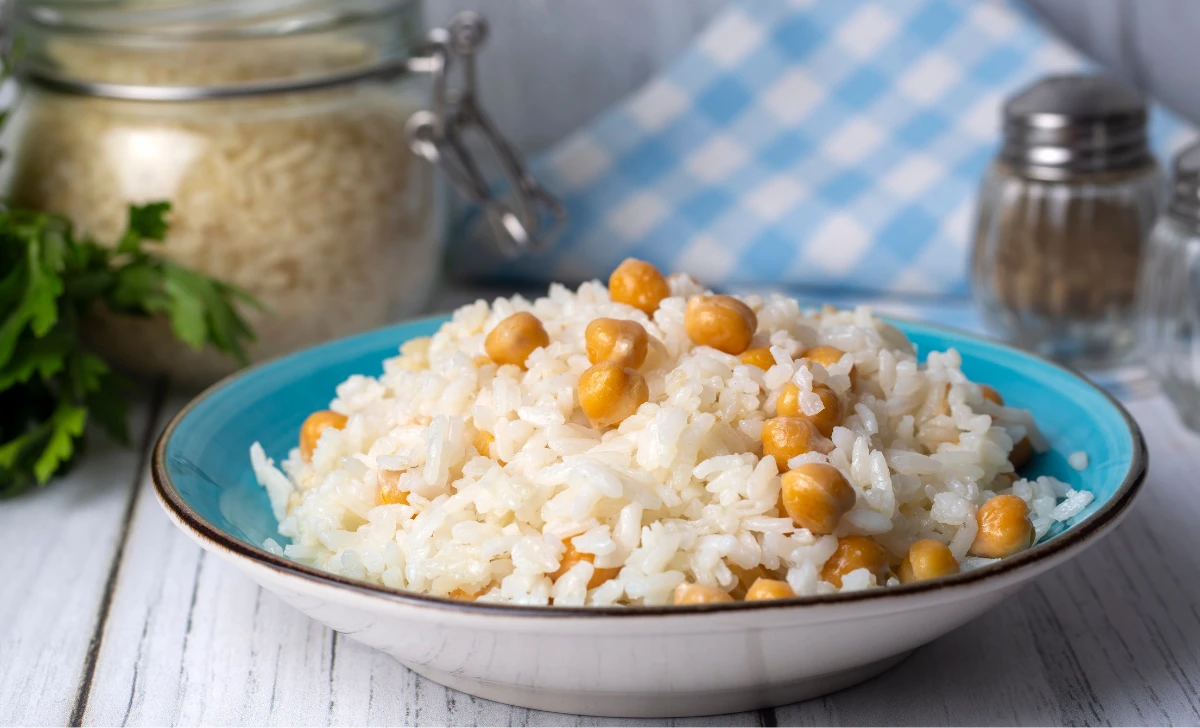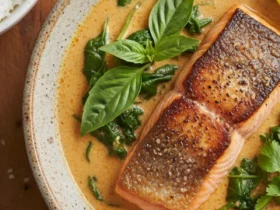Hey there, food enthusiasts! Today, we’re diving into the wonderful world of Turkish cuisine with a beloved dish – Nohutlu Pilav, a flavorful combination of tender chickpeas and aromatic rice. If you’re in the mood for a satisfying and wholesome meal, this recipe is just what you need. So, put on your apron and let’s get cooking!
[ez-toc]
History
Step back in time with me as we uncover the fascinating history behind the delectable dish we all know and love – Nohutlu Pilav. This cherished recipe has its roots deeply embedded in the heart of Turkish cuisine, carrying with it a tale of tradition, innovation, and the power of culinary creativity.
Ancient Origins
The origins of Nohutlu Pilav can be traced back to the ancient Silk Road, where trade routes intersected and cultures intermingled. As merchants and travelers embarked on their journeys, nourishing and hearty meals were essential to sustain them through long distances and diverse terrains. It is said that Nohutlu Pilav emerged during this era as a nourishing and portable meal that could withstand the demands of the journey.
A Nutritious Staple
Chickpeas, a key ingredient in Nohutlu Pilav, were not only readily available but also provided essential nutrients and sustenance. These legumes were revered for their protein content, making them an invaluable source of energy for travelers and laborers. The combination of chickpeas with rice created a balanced meal that was not only filling but also nourishing – a true testament to the resourcefulness of ancient cooks.
Evolution and Culinary Fusion
As time passed and cultures mingled, Nohutlu Pilav underwent subtle transformations, adapting to the flavors and spices of the regions it traveled through. The aromatic sautéing of onions and garlic not only added depth to the dish but also reflected the influence of neighboring culinary traditions. Over the centuries, the dish evolved into a harmonious blend of textures, tastes, and aromas.
Symbol of Hospitality
Hospitality has always been a cornerstone of Turkish culture, and Nohutlu Pilav became a symbol of warm welcome and generous feasting. In times of celebration, the dish was prepared with care and served to guests as a gesture of friendship and hospitality. Its presence on the table brought people together, fostering a sense of community and unity.
Culinary Resilience
Nohutlu Pilav’s enduring popularity can also be attributed to its versatility. In times of scarcity, when ingredients were limited, creative cooks found ways to elevate the dish with the addition of simple spices and seasonings. This ability to transform humble ingredients into a flavorful masterpiece reflects the resilience and ingenuity of Turkish cuisine.
Modern Interpretations
In modern times, Nohutlu Pilav continues to hold a special place in Turkish households and beyond. With the advent of convenient cooking methods and readily available ingredients, the dish has evolved further, accommodating a variety of dietary preferences and culinary experiments. From traditional family gatherings to contemporary food festivals, Nohutlu Pilav bridges generations and cultures with its timeless appeal.
Preserving Culinary Heritage
As we savor each spoonful of Nohutlu Pilav today, we not only relish its delightful flavors but also pay homage to a culinary heritage that has been passed down through generations. The dish encapsulates the essence of history, culture, and the shared joy of sharing a meal with loved ones.
So there you have it – the captivating journey of Nohutlu Pilav, from ancient trade routes to modern kitchens. This dish is not just a recipe; it’s a reflection of the stories, traditions, and connections that have shaped the culinary tapestry of Turkey and beyond. As you prepare and enjoy Nohutlu Pilav, remember that you’re taking part in a legacy that spans centuries, celebrating the magic of food and the richness of culture.
Time
| Step | Time |
|---|---|
| Preparing the Chickpeas | 8-12 hours (soaking) |
| Sautéing the Aromatics | 10 minutes |
| Cooking the Pilav | 30-40 minutes |
| Fluffing and Resting | 10 minutes |
| Garnishes and Final Touches | 5 minutes |
| Total Cooking and Preparation Time | Approx. 1 hour and 15 minutes |
Ingredients
| Ingredients | Quantity for 2 Servings |
|---|---|
| Dried Chickpeas | 1/2 cup |
| Long-Grain Rice | 1 cup |
| Olive Oil | 2 tablespoons |
| Large Onion | 1 |
| Garlic Cloves | 1-2 |
| Vegetable Broth | 2 cups |
| Ground Cumin | 1/2 teaspoon |
| Ground Turmeric | 1/4 teaspoon |
| Paprika | 1/4 teaspoon |
| Salt and Pepper | To taste |
| Fresh Parsley (Garnish) | A handful |
Directions
Step 1: Preparing the Chickpeas
- Rinse 1/2 cup of dried chickpeas thoroughly under cold water.
- Place the chickpeas in a bowl and cover them with water. Allow them to soak for 8-12 hours or overnight.
- After soaking, drain and rinse the chickpeas again.
Step 2: Sautéing the Aromatics
- In a large pot, heat 2 tablespoons of olive oil over medium heat.
- Add 1 large onion, finely chopped, and sauté until the onion becomes soft and translucent.
- Add 1-2 minced garlic cloves to the pot and sauté for another minute until fragrant.
Step 3: Cooking the Pilav
- Add 1 cup of long-grain rice to the pot and stir, allowing the rice to toast slightly with the aromatics.
- Pour in 2 cups of vegetable broth and mix well.
- Add the soaked and drained chickpeas to the pot.
- Sprinkle 1/2 teaspoon of ground cumin, 1/4 teaspoon of ground turmeric, and 1/4 teaspoon of paprika over the mixture.
- Season with salt and pepper to taste.
Step 4: Simmering and Fluffing
- Bring the mixture to a boil, then reduce the heat to low.
- Cover the pot with a lid and let the pilav simmer gently for 30-40 minutes or until the chickpeas are tender and the rice is cooked through.
- Once cooked, turn off the heat and let the pilav rest for about 10 minutes to allow the flavors to meld.
Step 5: Adding Final Touches
- After resting, fluff the rice with a fork to separate the grains.
- Sprinkle a handful of freshly chopped parsley over the pilav for a vibrant garnish.
Step 6: Serving and Enjoying
- Spoon the Nohutlu Pilav onto serving plates.
- Serve the pilav as a hearty and flavorful main dish, or pair it with yogurt, a squeeze of lemon, or your favorite side dishes.
- Enjoy every delicious bite and savor the blend of flavors and textures.
There you have it, the step-by-step directions for preparing a delightful serving of Nohutlu Pilav. Follow these instructions, and you’ll be well on your way to creating a delicious Turkish masterpiece that’s bound to impress your taste buds!
Equipment Required
Nutrition Information
| Nutrition Information | Per Serving |
|---|---|
| Serving Size | 1/2 cup (approx.) |
| Calories | 200 kcal |
| Total Fat | 6g |
| Saturated Fat | 1g |
| Cholesterol | 0mg |
| Sodium | 400mg |
| Total Carbohydrates | 31g |
| Dietary Fiber | 5g |
| Total Sugars | 2g |
| Protein | 6g |
| Vitamin D | 0% DV |
| Calcium | 4% DV |
| Iron | 10% DV |
| Potassium | 8% DV |
Nutrition values are approximate and can vary based on specific ingredients and portion sizes.
Remember that this table provides an estimated nutritional profile for the Nohutlu Pilav recipe. For accurate nutritional information, it’s recommended to use a nutrition calculator or consult with a registered dietitian. Enjoy your meal while keeping an eye on your dietary needs and preferences!
Tips
- Soak the Chickpeas: Be sure to soak the chickpeas for the recommended time to ensure they cook up tender and creamy.
- Choose the Right Rice: Opt for long-grain rice for that perfect fluffy texture in your pilav.
- Toasting the Rice: Toasting the rice with the aromatics enhances its nutty flavor and prevents it from becoming mushy during cooking.
- Simmer Gently: When simmering the pilav, use low heat to avoid overcooking or burning the bottom layer.
- Rest and Fluff: Allowing the pilav to rest after cooking allows the flavors to meld and the rice to fluff up naturally.
- Spice Levels: Adjust the spices according to your preference, but don’t be afraid to embrace the aromatic blend of cumin, turmeric, and paprika.
Pros & Cons
| Pros | Cons |
|---|---|
| ✅ Flavorful blend of chickpeas and rice. | ❌ Requires advance soaking of chickpeas. |
| ✅ Balanced nutritional profile. | ❌ Cooking time may be longer compared to some dishes. |
| ✅ Versatile – suitable as a main dish or side. | ❌ Requires attention to avoid overcooking or burning. |
| ✅ Incorporates aromatic spices for depth. | ❌ Some may not prefer the taste of certain spices. |
| ✅ Offers room for creativity with variations. | ❌ Not suitable for those looking for a quick meal. |
Conclusion
As we draw the culinary journey to a close, we invite you to embrace the warmth and richness of Turkish cuisine with open arms and a hungry heart. The Nohutlu Pilav recipe we’ve uncovered together is more than just a combination of ingredients; it’s a symphony of flavors, a testament to tradition, and an invitation to create cherished memories around the table.
Imagine the aroma of sautéed onions and garlic, the vibrant hues of turmeric and paprika, and the satisfying texture of tender chickpeas nestled in fluffy rice. Each forkful tells a story of ancient trade routes, cultural exchange, and the unwavering spirit of creativity in the kitchen.
While Nohutlu Pilav may seem like a simple dish, it’s a gateway to a world of culinary exploration. From pairing it with your favorite proteins to infusing it with your personal touch, there’s room for creativity at every step. Whether you’re an experienced chef or a culinary novice, this recipe invites you to partake in the magic of Turkish flavors and create a masterpiece that reflects your unique tastes.
So, don your apron and embark on this gastronomic adventure. Let the spices dance, the chickpeas tenderly embrace the rice, and the aromas fill your kitchen with anticipation. As you savor each bite, remember that you’re not just enjoying a meal – you’re embracing a culinary heritage that has stood the test of time.
Dive into the world of Nohutlu Pilav and savor the harmony of flavors and the joy of sharing a meal with loved ones. It’s not just a recipe; it’s an experience, a connection to tradition, and an opportunity to create lasting memories. Get ready to delight your taste buds and awaken your senses with the magic of Turkish cuisine. Bon appétit! 🍽️🌟
Facts
- 1. 🌍 A Culinary Passport: Silk Road Origins
- Did you know that Nohutlu Pilav’s journey began on the ancient Silk Road? As traders and adventurers traversed this historical trade route, they carried with them not only goods but also the art of flavorful cooking. Nohutlu Pilav emerged as a nourishing travel companion, making its way into our kitchens from the crossroads of cultures.
- 2. 🍲 From Humble Beginnings to Global Delight
- What started as a humble dish for travelers has now become a global culinary delight. Nohutlu Pilav’s hearty blend of chickpeas and rice transcended boundaries and won hearts around the world. It’s proof that even the simplest of ingredients can create culinary magic that resonates across cultures.
- 3. 🕰️ An Ancient Tradition Worth the Wait
- Patience is key when preparing Nohutlu Pilav. The art of soaking chickpeas overnight might seem like a step in the past, but it’s a practice that enriches the dish’s texture and flavor. So, while you wait for those chickpeas to soften, remember that you’re embracing a culinary tradition that dates back centuries.
- 4. 🧙♂️ Spices: The Wizards Behind the Flavor
- Cumin, turmeric, and paprika – the trio of spices in Nohutlu Pilav’s magical potion! Just like wizards concoct spells, these spices weave an enchanting flavor profile that awakens the senses. They transform a simple dish into a symphony of tastes that dance on your palate with every bite.
- 5. 🍽️ Where Tradition Meets Creativity: The Versatile Canvas
- Nohutlu Pilav isn’t just a recipe; it’s a canvas for your culinary creativity. Whether you add roasted veggies, experiment with spices, or customize it to your liking, the pilav invites you to paint your flavor masterpiece. So don your chef’s hat and infuse your own magic into this beloved Turkish dish!
FAQ’s
Can I use canned chickpeas instead of dried ones?
Yes, you can use canned chickpeas for convenience. Make sure to drain and rinse them before adding to the recipe.
Can I substitute the vegetable broth with chicken broth?
Absolutely! You can use chicken broth as a substitute for vegetable broth if you prefer. It will add a slightly different flavor profile.
How can I make this recipe gluten-free?
To make this recipe gluten-free, ensure the vegetable broth is gluten-free and choose a certified gluten-free rice variety.
Can I freeze the leftovers?
Yes, Nohutlu Pilav freezes well. Store it in an airtight container and thaw before reheating.
What can I serve with Nohutlu Pilav?
You can pair it with grilled meats, fresh salads, yogurt, or even enjoy it on its own as a satisfying main dish.
How do I prevent the rice from becoming mushy?
Toast the rice with the aromatics before adding liquid. This step helps the rice maintain its texture and prevents it from becoming overly soft.
Can I adjust the spice levels to my preference?
Absolutely! Feel free to adjust the spices according to your taste preferences, creating a flavor profile that suits you.
Can I use brown rice instead of white rice?
Yes, you can use brown rice for a nuttier and more nutritious option. Just note that the cooking time may be longer.
What’s the history behind Nohutlu Pilav?
Nohutlu Pilav dates back centuries and is rooted in the rich culinary traditions of Turkey. It was originally a nourishing and portable dish for travelers.
Can I add other vegetables to the pilav?
Of course! You can get creative and add roasted vegetables like bell peppers, carrots, and zucchini to enhance the dish’s flavor and nutritional value.












Leave a Review